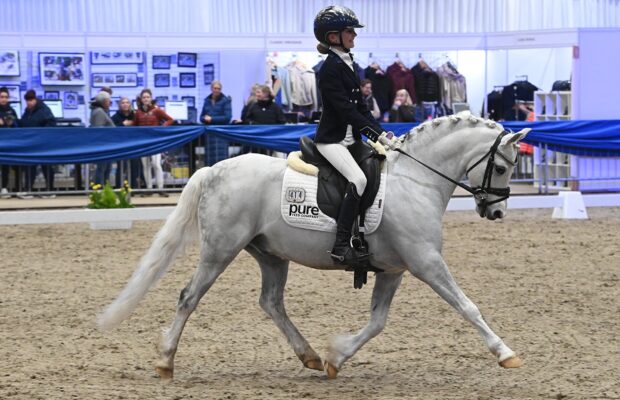Jumping a great round is about much more than just clearing the fences. How you get from fence to fence is a key part of the round, and flying changes can enhance that. In this article from the H&H archives, H&H asked eventer-turned-trainer Tracey Dillon for her tips on teaching flying changes
Watch any top showjumper and you can’t fail to notice how smooth their rounds are; their horses landing effortlessly on the correct lead or doing a flying change as needed with ease.
Having your horse on the correct lead helps maintain a fluid, powerful yet balanced canter, which is essential when tackling bigger tracks. This is something which can be taught to most horses, says trainer and former international eventer Tracey Dillon.
“There are elements to jumping a good round which can be divided into ‘nice to have’ and ‘must have’ — and as the tracks get bigger, flying changes move from the first category to the second. Either that, or you need to be able to counter canter your horse effectively to maintain a good canter,” says Tracey, who used the latter when jumping a former racehorse right up to Foxhunter level, as the horse struggled to canter in balance on the left leg in the early stages of his new career.
“The quality of the horse’s canter is absolutely crucial; without power and forward movement, you’re not going to get the jump in the stride you need and it will be difficult to do a flying change.
“So any plan to teach your horse flying changes has to start with ensuring you have the power to take the horse through the energy and effort required to shift the balance of half a tonne of bodyweight from one leading leg to the other,” says Tracey.
In preparation for teaching flying changes, Tracey advises focussing on canter to walk, and walk to canter transitions, using a half pirouette to aid the transition back into canter.
“This gets the outside hind leg stretching, as well as getting the horse straight through himself to allow the balance to be level when changing leg,” she says.
Teaching changes for dressage
When training horses to do flying changes for dressage or other flatwork, Tracey advises using the same method, but focussing on teaching specific leg aids for left or right canter.
This ensures the horse is very clear, when the flying change aid is applied, which canter lead is required.
“Flying changes for jumping are about being fluid with the horse forward and in an uphill canter afterwards. It isn’t essential that the front and hind legs change at precisely the same time — after all, you’re not being marked on it — but for dressage the lead change itself needs to be precise.”
In this scenario, Tracey advises using the method above (canter/walk, walk/canter and half pirouette training) and getting the horse to the point where it can be ridden round the outside of the arena and complete eight to 10 walk to canter transitions onto the correct lead as requested by the rider.
“You have to be at the point where you can achieve this perfectly, on a straight line and in a balanced and fluid fashion, before moving on to ask for a flying change,” warns Tracey, who adds that if the horse still struggles to grasp what is being asked having got the stage above, a pole raised at one end can be used to aid the change.
“Poles are a common way of teaching lead changes for jumping, but can be useful here too.”
Teaching flying changes over a pole
When training jumping horses to do flying changes, raised poles are a good way of encouraging the horse to land on the correct leg or to change as required by the rider.
“Start with a couple of poles in the arena; one raised left to right, the other right to left. As you canter over the poles, open your hand and turn the horse in the desired direction to encourage him to change leg, first one way then the other.”
Skilled riders are able to influence the leg the horse lands on by subtle shifts in position while jumping the fence, but for less experienced riders or horses which repeatedly land on the same leg over a fence, a landing pole is a great way of getting lead changes, says Tracey.
“Using a small cross pole or upright of about 80cm, place a slightly-raised landing pole nine feet behind the fence. This encourages an elevated landing stride.
“A placing pole used at 90 degrees to the landing pole is another way to reinforcing the horse to land on the correct lead. Again, aim for that elevated landing stride and make sure you open your hand and turn the horse’s head to the side required to help him find the right way.”
Whatever the method used, Tracey emphasises the need to avoid disturbing the quality of the canter when asking for flying changes.
“A powerful, forward canter is what you’re looking for — don’t let achieving a flying change interrupt that. You can always use counter canter in the ring until you’ve perfected lead changes at home.”
- Looking for more training tips and advice from top riders and trainers? Subscribe to the Horse & Hound website
You might also be interested in:

Learn from the best: William Fox-Pitt’s top tips for eventing success

Isobel Wessels: 9 tips for dressage success

Does your horse rush when jumping? Tips from an expert to help solve this problem

10 training tips that top riders swear by

Subscribe to Horse & Hound magazine today – and enjoy unlimited website access all year round




